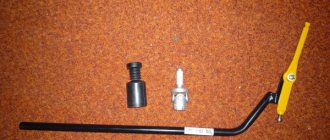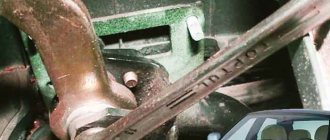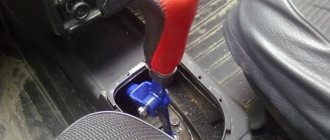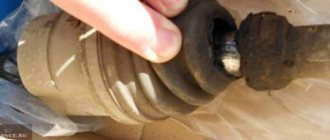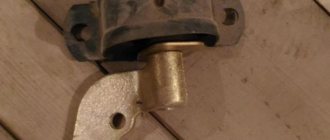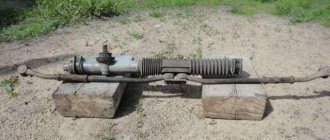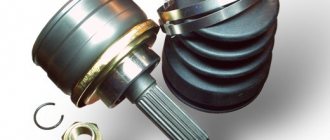Often this mechanism is broken and the rear one turns on instead of the first one. It turned out that way for me too.
On VAZ 2110, 2111, 2112 cars, reverse gear is engaged by pressing the lever down-left-forward. If the mechanism is broken, then both gears shift to the left and forward. And next to each other. Rear - to the left all the way. The first one is a little short. Without skill, it is easier to hit the back one than the first one. Apparently people after nine try to turn it on in the same way: to the left all the way and push it further forward. As a result, either the overlay breaks (the new one is shown in the photo):
Or plastic on the axle (pictured is mine, worn out and broken):
You can change the axle directly from the car interior. The overlay too, I think. In order to get to the mechanism you need to remove the leatherette cover.
It is held on a frame. Frame with snaps. Latches in the middle. It is enough to pick up two and pull out the frame.
Lift it up and we will see the cover and the axle with a plastic tip (I don’t know how to do it correctly).
When you press the lever down and to the left, the tip fits into the groove, which allows you to deflect the lever more to the left and get into reverse gear. If you didn’t press the lever, but simply moved it to the left, then it rests on the pad and doesn’t go further to the left—we end up in the first one.
In order to replace the axle, you need to remove the screw and nut:
The M8 nut can be unscrewed with a 13mm wrench. But the screw could not be unscrewed right away. First I tried it with a cardan at 90 degrees. Then I unscrewed one screw to widen the gap in the plastic:
And he stuck a thin slotted screwdriver in there, while tilting the lever to the right:
Next, remove the axle and insert a new one. And everything is in reverse order. Everything is done in 20 minutes. I spent more time running around for screwdrivers.
For the repair I needed:
Tools: 1. Screwdriver 2. 13 mm wrench
Spare parts: 1. Repair kit for gearbox shifter for cars of the LADA 110 family - cost 154 rubles.
The car's transmission allows you to change the torque from the internal combustion engine before transmitting it to the drive wheels. This makes it possible to change the speed of the vehicle, maintain engine operation in the optimal speed range, etc.
Also, thanks to the gearbox, you can change the direction of movement, that is, the vehicle gets the opportunity to move not only forward, but also backward. At the same time, on cars for forward movement, step boxes have several gears, while there is only one reverse speed.
It should be noted that quite often drivers encounter a malfunction when reverse gear does not engage, and on different types of gearboxes (manual transmission, automatic transmission, manual transmission, etc.). Next, we will look at the main reasons why reverse gear does not engage in manual transmissions, as well as in automatic transmissions.
Read in this article
VAZ 2110 gearbox locks
- Registration
- Entrance
- To the beginning of the forum
- Forum Rules
- Old design
- FAQ
- Search
- Users
vek
I don't know what you have, first of all adjust the backstage! If that doesn't help, disassemble the gearbox. And so go to SEARCH, there are tons of similar ones!
PS only knocks out the first one? or the back one?
Most likely the synchronizer is worn out.
“Sometimes it’s better to chew than to talk. "(c) I’ve never understood people who are “off topic” but consider it their duty to blurt out something. Well, what does the synchronizer have to do with it?
On this topic. — adjusting the rocker — look at the engine mounts (maybe it’s hanging around too much in the engine compartment and knocking out the gear?) — checking the presence of the locking ball and the integrity of the first gear locking spring (have you by any chance changed the oil in the gearbox? Otherwise there are “craftsmen” who replace the plug drain, unscrew the locking plug)
“Sometimes it’s better to chew than to talk. "(c) I’ve never understood people who are “off topic” but consider it their duty to blurt out something. Well, what does the synchronizer have to do with it?
Despite the fact that I had a similar problem. Maybe I didn’t call it the synchronizer correctly, or something else, but it’s a gear with a spring-loaded base. At the service center they removed the box and disassembled it, and then they showed me this gear with strong metal wear. Sorry for interfering with your intellectual conversation.
Despite the fact that I had a similar problem. Maybe I didn’t call it the synchronizer correctly, or something else, but it’s a gear with a spring-loaded base. At the service center they removed the box and disassembled it, and then they showed me this gear with strong metal wear.
A synchronizer is a device designed to equalize the rotation speeds of the primary and secondary shafts at the moment of gear shifting. It cannot have any influence on the “knocking out” of the transmission. We are probably talking about the 1st-2nd gear clutch? Then yes, it's possible. But coupling wear means runs > 200 thousand km. Or a long drive with a “crispy” second one. I guess vek
The mileage is still less.
Sorry for interfering with your intellectual conversation.
Despite the fact that I had a similar problem. Maybe I didn’t call it the synchronizer correctly, or something else, but it’s a gear with a spring-loaded base. At the service center they removed the box and disassembled it, and then they showed me this gear with strong metal wear.
A synchronizer is a device designed to equalize the rotation speeds of the primary and secondary shafts at the moment of gear shifting. It cannot have any influence on the “knocking out” of the transmission. We are probably talking about the 1st-2nd gear clutch? Then yes, it's possible. But coupling wear means runs > 200 thousand km. Or a long drive with a “crispy” second one. I guess vek
The mileage is still less.
Sorry for interfering with your intellectual conversation.
The wear of the coupling is not necessarily mileage > 200 thousand km. An unadjusted clutch or its constant under-pressure is enough, that’s the clutch and the tire. When the clutch wears out, the transmission begins to fall out (even without force on the gearshift knob), and then as it wears out, the transmission simply begins to knock out (even if you hold the clutch with your hand). The gear may also fall out due to wear on the rods of the gearbox forks (on the recesses for the ball). In general, first check the engine mounts (although on the 2110 the rocker is attached with a second lever directly to the engine, unlike the 08-099 design, which virtually eliminates the pederaci falling out when moving the engine), the presence and functionality of the transmission rod lock.
Features of fastening the VAZ 2110 gearbox
Box vaz 2110
One of the most obvious problems that require an immediate solution is replacing the gearbox in a VAZ 2110. And naturally, in the process you have to deal with such a component as mounting the VAZ 2110 gearbox. On the VAZ 2110, the gearbox mount has some features that make removing it from the car very problematic. To perform this work, you must have an assistant who will help in this difficult task. In addition to dismantling and disassembling the gearbox, it is also necessary to reassemble it. The assembly process is no less problematic.
Sequence of actions when replacing the box
VAZ 2110 box mount
The sequence of actions should be as follows:
- The battery is removed from the vehicle.
- The process of draining the oil from the gearbox is taking place.
- The starter is disconnected.
- The clutch drive cable is dismantled.
Note: the cable is connected to the clutch release fork. The cable is located in a bracket on the box. To remove it, you need to pull it out of the socket.
- The speed sensor is connected to a block with wires. The pad can be detached by compressing the springs.
- The device has a bolt that connects the ignition module bracket and the gearbox. It must be removed. There are two bolts at the top of the transmission and engine connection. This is the VAZ 2110 gearbox fastener.
Note: The front bolt (which is located in the car along its direction) is shorter than the subsequent bolt.
- The rear light switch is connected to a block with wires. The block with wires is disconnected from the bottom of the car.
- The bolts securing the torque rod to the gearbox are unscrewed. There are two of them.
Fastening the VAZ 2110 box
Note. It should be noted that the reaction rod has contact with the gear selection rod hinge. By unscrewing the fastener, the clamp is loosened. For the convenience of subsequent actions, the rod moves to the side.
- The next step is to remove the wheel drive.
Note: There are two drives here. They can be roughly divided into right and left. A plug must be inserted into the right drive. It must be firmly secured, as it can slip out at the most inopportune moment. The drive, located on the left side, does not need to be completely removed. It is enough to move it a little to the side, in such a way that it does not interfere with subsequent actions.
- Unscrew two bolts on the left ball joint and steering knuckle. They are subsequently removed.
- In the lower right part, where the VAZ 2110 gearbox is attached to the body with a nut, it must be unscrewed to the side.
Note: Some vehicles that use a fuel injection system have a special intake pipe bracket under this nut. It must be removed and the pin left.
- The fastening nut may be loosened if some elements are in the way.
Fastening the box with the rocker of the VAZ 2110
- The clutch housing has three bolts on the bottom cover that hold it in place. They must be removed and the cover removed.
- There is a bolt in the left corner of the gearbox mounting to the engine. It must be unscrewed and set aside.
- Move the engine up a little.
Causes
The reasons why reverse gear engagement is poor or difficult may be as follows:
- loosening of the fastening clamp of the rocker, due to which the length of the rod is not enough to fully engage the gear;
- jamming of the reverse speed lock;
- spring breakage and debris getting into the guide grooves of the gear selection mechanism;
- spontaneous loosening of the selection mechanism mounting bolts;
- the clamp bolt is cut off;
- wear of the clutch disc and release bearing;
- incorrect adjustment of the clutch and clutch pedal;
- low oil level in the box or the need to replace it.
READ How to change rear pads on a VAZ 2109
Changing the gearbox oil
If the oil seal on the rod is damaged, oil leaks out of the gearbox housing, and dirt can get into the box itself. These factors may be the reason why reverse gear stops engaging. In addition, the oil in the box loses its properties during operation, so it must be replaced preventively at least once every 35–40 thousand kilometers. Before replacing, you need to check the condition of the oil in the box. To do this, you need to remove the oil dipstick installed in the gearbox housing and visually assess the quality of the oil. The presence of metal and dirt particles in the oil on the dipstick is unacceptable. The oil itself should be quite liquid and not stick to your hands in a thick layer.
To replace, you will need the following materials and tools:
- New oil. When purchasing oil, you need to consider the type of gearbox. For fairly rare four-speed gearboxes, three liters of oil are required, for newer five-speed ones - 3.3 liters. The oil itself must have a tolerance of 80W-85, the manufacturer does not matter.
- A container for draining old oil with a volume of at least 4 liters.
- A funnel with a hose for pouring new oil or a syringe.
- Wrenches 12 and 17 mm of any type.
- Rags and cleaning solvent.
The actual work order is as follows:
- Place the car with the heated gearbox on the pit.
- Remove the rubber plug from the gearbox ventilation valve installed on the top of the crankcase.
- Clean the valve and plug from dust and dirt. It is convenient to clean parts with thin wire and a rag.
- Reinstall clean parts.
- Wipe off dirt from the bottom of the box. Unscrew the plug on the bottom of the box housing.
- Place a container under the drain hole and drain the oil. It will completely merge in at least 20-25 minutes.
- After this, screw the drain plug back into place and carefully tighten it with a wrench. First, the plug and hole must be thoroughly wiped with a rag.
- Pour fresh oil through the oil level dipstick hole in the box.
- During filling, it is necessary to check the oil level, which normally should be between o and “MAX” on the dipstick rod.
- If there is an overflow, the oil can be pumped out with a large medical syringe with a tube on the spout.
- Within a few days after the change, it is advisable to check the level and appearance of the oil. You also need to make sure that there are no leaks through the plug and box seals.
INSTEAD OF THE FIRST GEAR, THE REVERSE GEAR OF THE VAZ 2110,2111,2112 is engaged.
VAZ gearboxes there is no hole for the dipstick. To fill the oil in the crankcase of such boxes there is a control hole closed with a threaded plug. Filling is carried out using an oil syringe. The oil level is considered normal when it reaches the lower edge of the inspection hole.
Adjusting the gear shift lever and drive
All that remains is to adjust the gear shift lever and clutch release drive. To do this, you also need to know a few simple rules. To check the gear shift lever:
- The transmission control rod has a clamp nut. It is necessary to unscrew the bolt quite a bit.
Note: Access to the nut is from underneath the vehicle.
- It is necessary to have access to the free movement of the gear selection rod. After some operations to increase the connector, it is necessary to put the rod in the neutral position.
- The subsequent operation takes place inside the car. The gearbox cover is removed from the lever. It is enough to move it down.
- In the opened space, you need to find the reverse locking bracket.
- The lever must be fixed in the position where the groove of the lever axis stop is pressed against the template.
Note: it is necessary to carry out the shift smoothly and carefully, since the bracket itself can be deformed.
- From the bottom of the car, the rod play is placed in the “backward” position. The angular play must be placed counterclockwise.
- The nut of the clamp block under the car is tightened. The clamp needs to be moved forward a little. A space of 2-3 millimeters is provided.
The clutch pedal is adjusted in the following way:
- The car is installed on a flat surface. The minus terminal must be disconnected from the battery.
- A ruler is placed on the floor near the pedal. The measurement is taken from the floor to the rubber pad. If the indicator exceeds 160 millimeters, the pedal should be adjusted.
- When the hood is open, there is a metal clutch cable that should already be disconnected. Adjustment occurs by turning the nut. By tightening the nut, the gap decreases. Unscrewing the nut increases the pedal travel.
- Press the clutch pedal several times. If the results change, it is necessary to adjust the nut again.
- The rubber limiting sleeve moves into the fork to the limit.
Gearbox VAZ 2110
Like any car, the VAZ 2110 is equipped with a gearbox. In the case of the designated model, this mechanism has 5 stages and is controlled via a shift lever, which, in turn, is located inside the car.
To ensure that there are no problems with the operation of your VAZ 2110, and that you can correct all kinds of failures yourself, you will need to understand the principles of operation and the design of the gearbox. We will also consider the process of changing the oil for the “ten”.
Gearbox VAZ 2110
The design of the gearbox is as follows: to ensure switching, the gearbox contains a so-called input shaft, which consists of a special block and gears. They are located in such a way that they are in constant mesh with the drive gears from speeds 1 to 5 (those that allow you to move forward). There is also another secondary shaft on which the main gear drive gear and synchronizers are located, which ensure forward movement. In addition, bearings and the so-called oil sump are located here.
The VAZ 2110 device assumes the presence of a two-satellite type differential. The drive part of the gearbox consists of a shift knob, a ball joint, a rod, a rod and mechanisms for selecting gears. The presence of jet thrust is explained by this - this is a measure to protect the gearbox from so-called “overshoots”. This traction is fixed with a support and a power unit.
Basic faults
When switching the lever to the neutral position, an extraneous noise is heard. In this case, the issue may be the low quality of the lubricant or its absence. If after changing the oil the noise in the manual transmission does not disappear, the issue may be wear on the input shaft bearings, defects on the gear teeth, or misalignment of the shafts. In case of any of the listed malfunctions, the necessary elements must be changed.
Gear shifts are difficult. The issue may be a breakdown of the gear selection mechanism, a defect in the cardan joint, or incomplete disengagement of the clutch. Also, difficult operation of a manual transmission is sometimes caused by loosening of bolted connections or damage to the rod lever.
In this case, you need to adjust certain elements and replace damaged gearbox parts.
The transmissions turn off on their own. This malfunction may be associated with wear or damage to the gear teeth, loosening of the second shaft nut, wear of the rods and deformation of the forks, as well as increased vibration of the motor during operation. To solve the problem, you need to replace the faulty elements and adjust the drive.
Extraneous sound when shifting gears. The main reason for this is a breakdown of the clutch mechanism. Signs of a malfunction may also include oil leakage from the gearbox or increased noise when the car is moving in higher or lower gears. In the first case, you need to check all oil-containing elements for wear and replace them, and then change the oil. In the second case, the issue may be a failure of the secondary shaft bearings, which require replacement.
Adjustment work with the VAZ 2110 gearbox
Many of the owners of the VAZ 2110 mention cases when shifting gears is difficult, they are difficult to engage, and there are also frequent cases when these same gears are simply knocked out. Manufacturers have made sure that for such cases there is a special adjustment mechanism for the drive to select the speed.
This mechanism will be very useful when:
- The gearbox has been removed or was previously removed for repair work.
- One of the gears fails.
- Shifting gears occurs with effort, is difficult, or they simply get knocked out while the car is moving.
Provided that one of the described problems is typical and present in your VAZ 2110, you will need to make adjustments. It consists of the following steps:
- On the bottom of your car you will need to find the nut of the bolt that tightens the clamp that secures the rod required to carry out the gearbox control process. The nut will need to be loosened.
- Next, you need to move apart the grooves at the end of the rod using a screwdriver and also the crack on the clamp. Such manipulation will be required so that the rod can easily move relative to the gear selection rod. Set the rod itself to the neutral position.
- The shift knob must be freed from the cover.
- The lever is set according to a special pattern. In the rear speed locking bracket adjustment window, a template is set. Next, a stop for the lever axis is inserted in place of the template groove, and it is necessary to press without unnecessary effort in the transverse direction.
- Next, the axial play of the rod is adjusted in the rearward direction.
- The clamp is fixed a few millimeters from the end of the rod. Next, tighten the same clamp with a bolt.
Repairing the box
In the case where this kind of adjustment work did not bring much results, you will have to remove and disassemble the gearbox of your VAZ 2110. The main attention should be paid to the gears, since they are most often knocked out. This is especially true for first and second speeds. It will also be important to check the latch.
There are three latches in total in the gearbox. The very first of them is very long and is responsible for 1st and 2nd gears. Next comes the clamp for third and fourth gears, and the shortest of the clamps is intended for 5th gear.
complete gearbox assembly
Repair
If the described adjustment did not help you, you need to remove and disassemble the VAZ 2110 gearbox. Pay special attention to the fact that the gears with which the first and second speeds are engaged often knock out. Be sure to check each fastener.
Another complaint is that the second gear is difficult to engage and is often knocked out.
Here you can suspect the main culprits:
- the second one flies out most often because the gear teeth do not mesh well with the clutch that turns on the speeds;
- The tips of the gear teeth and clutch are already worn out, so the speed is difficult to engage. If you don’t intervene, it will soon fly out;
- as an option, when it knocks out on bumps, the clutch dies.
Sometimes (albeit rarely) when the second one does not turn on well enough and falls out, replacing the retaining spring helps. If the speeds often drop out, some of them are difficult to turn on, which means that half-measures will no longer help - the box needs to be overhauled.
Whether you do it yourself, or go to a service center where they will repair it for you and also adjust the gear shift mechanism, decide for yourself, based on your own experience and skills.
If you find an error, please select a piece of text and press Ctrl+Enter.
>
Problems
Often, VAZ 2110 owners voice a problem regarding the switching or departure of first gear. Most likely, the reasons lie in the following:
- synchronizer problems;
- damage to the retainer spring when the lever dangles and the gears are switched on randomly;
- damaged rod and fork.
A common problem is when the second gear is reluctantly engaged, or it is simply knocked out. The most likely causes of the problem:
- poor engagement of the gear and clutch that engages the gears;
- wear of gear teeth and coupling;
- problems with the clutch.
Let's sum it up
Taking into account the above information, it becomes clear that if the reverse gear does not engage, it is not always necessary to remove and repair the gearbox. For cars with manual transmission, special attention should be paid to the clutch and rocker.
One way or another, it is important to carry out regular gearbox maintenance and necessary adjustments. If the owner notices certain signs of problems with the transmission, it is necessary to stop using the vehicle and carry out a comprehensive diagnosis of the transmission.
Gears are difficult to engage or speeds on a manual transmission do not engage: the main causes of the malfunction and possible problems.
Gears do not engage when hot or it is difficult to engage a gear: the main causes and methods of troubleshooting a manual transmission.
Types of clutch drive. If the clutch pedal falls, the clutch has become soft, problems have arisen with the clutch: causes and repair of major faults.
Manual transmission gears (speeds) do not engage after replacing the clutch: main reasons, settings and adjustments. Diagnosis of problems, useful tips.
Reasons for difficulty shifting gears with the engine running. Transmission oil and level in the gearbox, wear of synchronizers and gearbox gears, clutch.
Why gears on a manual transmission are difficult to engage: the main reasons for difficulty engaging manual transmission gears. Clutch and transmission failures.
Changing the oil
According to the documentation, the lubricant component in VAZ 2110 engines and transmissions must be changed every 15 thousand kilometers or at least once a year.
So, we need to warm up the engine well and prepare the required oil and, preferably, a new oil filter, as well as the tools necessary for the job.
gearbox housing 2110
To drain the waste, you will need to unscrew the plug from the oil pan. Next, within 10-15 minutes, the oil is drained into a special container, which will need to be prepared in advance. Then the drain plug returns to its original position and is screwed tightly. Now you can replace the old oil filter with a new one (if necessary).
Now that the old oil has been drained, pay attention to its color and presence of inclusions. If the oil is dark brown in color and to the touch contains various types of inclusions such as metal dust or pieces of dirt, then the transmission will need to be flushed.
Operating principle and troubleshooting of the VAZ 2110 gear shift mechanism
Like any car, the VAZ 2110 also has a gear shift mechanism. The VAZ gearbox is five-speed, activated by a lever located in the car's interior.
In order to be able to fix problems yourself, you need to understand a little about how exactly the switching mechanism works, which is why there are cases when some speed does not turn on or goes out. And also know how to fix it on your own.
Reverse gear does not engage: common breakdowns
So, if engaging reverse gear is difficult or completely impossible, this breakdown is a common problem that can be encountered in different vehicles when changing gears.
Moreover, the rear does not engage both on manual and automatic transmissions (the reverse speed of the automatic transmission has disappeared). Naturally, in such a situation, it is important to discover the cause of the malfunction and eliminate the breakdown, since it is simply impossible to operate the car normally without reverse gear (the vehicle is actually deprived of reverse gear). Let's figure it out.
- Let's start with a manual transmission and consider the question of why reverse gear does not engage in a manual transmission. First of all, with a manual transmission the reverse gear fails much more often than with an automatic transmission. As a rule, the first signs of problems are a grinding, crackling or crunching sound in the reverse gear when engaged, the reverse gear is difficult to engage, it is difficult to engage the speed after a while, etc.
Checkpoint diagram
The gearbox design is as follows:
- To ensure gear shifting, the gearbox contains a primary shaft consisting of a gear block. They are constantly engaged with the drive gears from the first to the fifth speed (that is, those that are oriented towards driving forward);
- The secondary shaft is equipped with a drive gear for the main transmission, and it also has gear synchronizers that ensure forward movement of the driven gears. There are also bearings plus an oil sump;
- VAZ two-satellite differential, with the driven gear of the main gear attached to the flange of its box;
- the gearbox drive consists of a gear shift knob, a ball joint, a selector rod, a rod, gear selection mechanisms, and gear shifting mechanisms;
- Jet thrust is designed to protect the gearbox from flying out of gear. Its ends are attached to the support and the power unit.
Gear shift drive diagram
Reverse speed of automatic transmission does not engage
In practice, reverse gear may not be engaged in both manual and automatic transmissions. Taking into account the fact that automatic transmissions are different, it should be noted that some problems of manual transmission robots are similar to “mechanics”, while “classic” automatic transmissions have their own list of problems due to which the reverse speed disappears.
- The level of the ATF transmission fluid has deviated from the norm, the fluid in the automatic transmission is contaminated or has lost its properties. As you know, an automatic transmission is extremely sensitive to the level and quality of oil. For this reason, the check should begin with the transmission fluid.
Please note that both under and over levels can cause gears to shift incorrectly. Also, ATF oil has a limited service life, that is, the fluid needs to be changed every 40-60 thousand km, contamination, cloudiness, etc. are not allowed.
- Wear of automatic transmission clutches (friction discs). This malfunction often affects both reverse gear R and gears in drive mode D. Problems with clutches lead to gears not being engaged, and certain speeds may disappear (for example, the car goes to 1 and 2, but not 3 and 4, as well as reverse gear). To fix the problem, you will need to replace the automatic transmission clutches.
- Other automatic transmission malfunctions and breakdowns. For example, if the splines of the drive drum are cut off, the machine can move forward, but there is no reverse gear. There may also be complete absence of movement both forward and backward. To solve the problem, the drum needs to be replaced.
Adjustment
On a VAZ 2110, it is not so uncommon for the gears to shift poorly or get knocked out. A mechanism for adjusting the speed selection drive is provided specifically for this purpose.
Adjustment may be necessary if:
- the box was recently removed for repairs;
- one of the gears falls out;
- the speeds do not engage well or simply get knocked out when the car is moving.
If you have one of these problems, try making adjustments first. Its sequence:
- Under the bottom of the VAZ 2110, find and slightly loosen the nut on the bolt that tightens the clamp that secures the rod designed to control the gearbox;
- Use a screwdriver to slightly move apart the grooves in the end of the rod and the resulting gap on the clamp itself. This is necessary to ensure easy movement of the rod in relation to the gear selection rod. Place the rod in the neutral position;
- Release the shift knob from the cover in the cabin;
- Align the lever using a special template. This is done like this: install a template in the window of the rear speed lock bracket lining. After this, insert the lever axis stop into the groove of the template, pressing it without unnecessary force in the transverse direction;
- Then adjust the axial play of the rod in the rear direction, and its axial play by turning to the left;
- Install the clamp, not reaching a few millimeters from the end of the rod. Then tighten the clamp thoroughly with the bolt.
Troubleshooting
Many transmission malfunctions that cause the reverse gear to disappear or fall out can be eliminated without removing the unit from the car.
VAZ 2110 will not start. Revival. Reverse gear does not engage.
If the cause is a loosening of the bolt securing the clamp on the rod, then to correct the defect it is necessary:
- Place the car on a lift.
- Completely loosen the clamp nut.
- Place the gearshift lever in the fully engaged reverse gear position.
- Fully engage reverse gear at the gearbox using the shift rod on the crankcase.
- Tighten the clamp mounting bolt.
Spring replacement
Often, owners change the entire mechanism assembly, which costs on average about 2 thousand rubles. But you can disassemble the mechanism and get by with replacing the spring, which costs up to 50 rubles.
You need to do the following:
- Remove the stopper from the blocker axle and remove the axle itself.
- Unscrew the lever axle nut.
- Remove the axle and replace the spring.
- Reassemble in reverse order.
